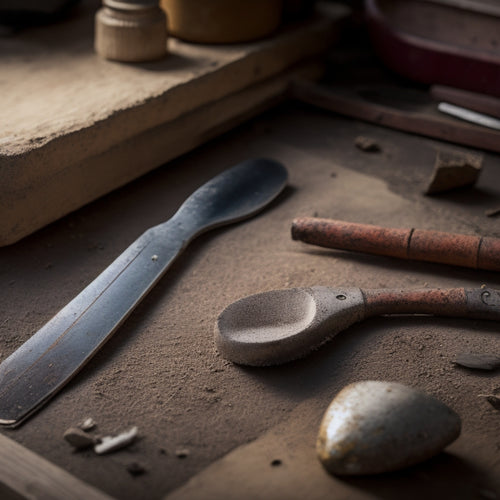
Drying Time Calculator for Home Renovation Projects
Share
You need an accurate drying time calculator to plan your home renovation project effectively, as sealant curing times vary considerably depending on the type of sealant, environmental conditions, and surface preparation. Temperature, humidity, and sealant thickness affect drying time, making it essential to take these factors into account when choosing a sealant. Accurate input values and understanding the curing process are fundamental for ideal results. To guarantee your project stays on track, it's crucial to factor in drying times, and a well-informed approach will help you achieve a successful bond - now, discover the key elements that will elevate your project planning to the next level.
Key Takeaways
• Accurate drying time calculations depend on considering factors like temperature, humidity, and sealant type for home renovation projects.
• Manufacturer-provided drying times and instructions are crucial for optimal results and should be strictly followed.
• Drying time calculators require precise input values, including sealant thickness and environmental conditions, for reliable estimates.
• Combining drying techniques, such as ventilation and heat, can moderately reduce overall drying time, but may not always be necessary.
• Understanding the curing process of different sealant types, such as acrylic, silicone, and polyurethane, helps in planning project timelines effectively.
Understanding Sealant Drying Times
You'll need to allow a specific amount of time for sealants to dry, as their curing times vary considerably depending on factors such as type, brand, and environmental conditions.
Proper sealant application requires careful planning, and understanding the drying time is essential to achieving a successful bond.
Before applying sealants, you must verify the surface is properly prepared. This includes cleaning the surface, removing any dirt, oil, or moisture, and roughening the surface to create a strong bond.
The type of surface preparation required will depend on the specific sealant being used and the surface material. For example, some sealants may require a primer or special cleaning solution to guarantee a strong bond.
You should always follow the manufacturer's instructions for surface preparation and sealant application to achieve the best results.
Factors Affecting Drying Time Calculator
The drying time calculator takes into account several key factors that greatly influence the sealant's curing process, including temperature, humidity, and sealant thickness. These factors can greatly impact the overall drying time, and it is vital to take into account them when planning your home renovation project.
| Factor | Influence on Drying Time |
|---|---|
| Temperature | Higher temperatures accelerate curing, while lower temperatures slow it down. |
| Humidity | High humidity slows down curing, while low humidity speeds it up. |
| Sealant Thickness | Thicker sealants take longer to cure, while thinner ones dry faster. |
As you use the drying time calculator, you'll need to input accurate values for these factors to get an accurate estimate. Additionally, proper application techniques and surface preparation are important in making sure the sealant cures correctly. If the surface is not clean, dry, and free of contaminants, the sealant may not adhere properly, leading to extended drying times or even failure. By taking into account these factors and taking the necessary precautions, you can guarantee a successful sealant application and a smooth renovation process.
Sealant Types and Drying Speeds
Different sealant types have varying drying speeds, with some curing in a matter of minutes and others taking several hours or even days.
As you plan your home renovation project, understanding the sealant application and curing processes is essential to guarantee a successful outcome.
Acrylic-based sealants, for instance, are known for their fast-drying properties, typically taking around 15-30 minutes to dry to the touch.
On the other hand, silicone-based sealants take longer to cure, usually between 1-24 hours, depending on the specific product.
Polyurethane-based sealants fall somewhere in between, with drying times ranging from 30 minutes to several hours.
When choosing a sealant, consider the specific requirements of your project.
If you need a quick fix, an acrylic-based sealant might be the best option.
However, if you're looking for a more flexible and durable seal, a silicone-based sealant might be a better fit.
Understanding the curing processes of different sealant types will help you plan your project timeline and guarantee a successful sealant application.
Environmental Conditions and Drying
As you prepare to apply sealants, also consider the environmental conditions that can greatly impact drying times. Humidity levels, in particular, play a significant role in sealant drying. High humidity slows down the evaporation process, leading to longer drying times. Conversely, low humidity accelerates evaporation, resulting in faster drying. It's vital to monitor humidity levels in your workspace, as even minor fluctuations can affect drying times.
Temperature fluctuations also influence drying speeds. Most sealants dry faster in temperatures between 60°F and 80°F (15°C and 27°C). However, extreme temperatures can hinder or accelerate the drying process. For instance, high temperatures can cause sealants to dry too quickly, leading to uneven coats or bubbles. On the other hand, low temperatures can slow down the drying process, making it difficult to achieve a smooth finish.
When working on your home renovation project, be mindful of these environmental factors to guarantee the best drying conditions. By controlling humidity levels and temperature fluctuations, you can minimize delays and achieve professional-looking results.
Calculating Drying Time Accurately
You'll need to factor in the sealant's specific drying time, which is typically provided by the manufacturer, to calculate drying time accurately. This information is essential in determining the overall drying time for your project.
Additionally, you should consider the drying techniques used, as different methods can greatly impact the drying process. For instance, using a fan or increasing the temperature can speed up the drying process, while using a slower-drying sealant may require more time.
To get an accurate calculation, imagine the following scenarios:
-
A small, well-ventilated room with a fast-drying sealant, where drying time is reduced to a few hours.
-
A large, poorly ventilated room with a slow-drying sealant, where drying time is extended to several days.
-
A room with a combination of drying techniques, such as using a fan and increasing the temperature, where drying time is moderately reduced.
Frequently Asked Questions
Can I Speed up the Drying Process With a Fan or Heat Gun?
When speeding up the drying process, you're considering using a fan or heat gun.
You'll find that a fan can be effective in circulating air, but its effectiveness depends on the surface area and air flow.
However, be cautious when using a heat gun, as it can cause damage or create hot spots.
Always follow heat gun safety guidelines to avoid overheating or igniting materials.
Are There Any Drying Time Calculators Available for Free Online?
'Oh, you want to be a master of project planning, huh? Well, buckle up, because the internet's got your back!
You'll find a plethora of online resources that'll calculate drying time for you, so you can focus on the fun stuff – material selection, for instance. From paint to plaster, these calculators will give you the lowdown.
Just type 'drying time calculator' into your favorite search engine, and voilà! You'll be a pro in no time, with precision drying times at your fingertips.'
How Do I Know if a Sealant Is Fully Dry and Cured?
When working with sealants, you'll want to make certain they're fully dry and cured.
To determine this, you'll need to take into account the sealant type and its specific curing indicators.
For example, some sealants may change color or become tack-free when cured, while others may require a specific temperature or humidity level.
Always follow the manufacturer's instructions and look for these indicators to confirm the sealant has fully dried and cured.
Can I Apply a Second Coat Before the First Coat Is Fully Dry?
Imagine a delicate dance of molecules, where patience is the maestro.
When you're tempted to apply a second coat before the first is fully dry, remember that hasty decisions can lead to a weakened bond.
The key is to master application techniques and respect drying conditions. If you're unsure, it's better to wait.
Premature application can compromise the sealant's integrity, leading to a fragile finish.
Take a deep breath, and let the first coat do its magic before adding more.
Do Drying Times Vary Between Different Sealant Brands and Products?
You're wondering if drying times vary between different sealant brands and products. The answer is yes, they do.
Different sealant types, such as silicone, polyurethane, and acrylic, have unique drying properties.
Even within a type, brand comparisons reveal varying drying times. For instance, a silicone sealant from Brand A might dry in 24 hours, while a similar product from Brand B takes 48 hours.
It's essential to consult the product's instructions and data sheet for specific drying time information.
Conclusion
You've finally figured out how to calculate the drying time for your home renovation project. Now, you can stop staring at the ceiling, willing the sealant to dry faster.
Remember, it's not magic, it's science. And if you've followed our guide, you should have a decent understanding of the factors that affect drying time.
But let's be real, you're probably still going to check on it every five minutes, hoping it's dry. Go ahead, we won't judge you.
Related Posts
-

What Plastering Tools Do You Need for Renovation
You'll need a range of specialized tools to tackle a plastering renovation project efficiently and effectively. Essen...
-

Why Tool Exchange Matters in Home Renovation
You rely on a well-maintained tool belt to complete home renovation projects efficiently, and having access to the ri...
-

Why Inspect Stucco Repair Equipment Before Renovation
When starting a stucco repair renovation, you need to inspect your equipment to prevent accidents, save time and mone...


